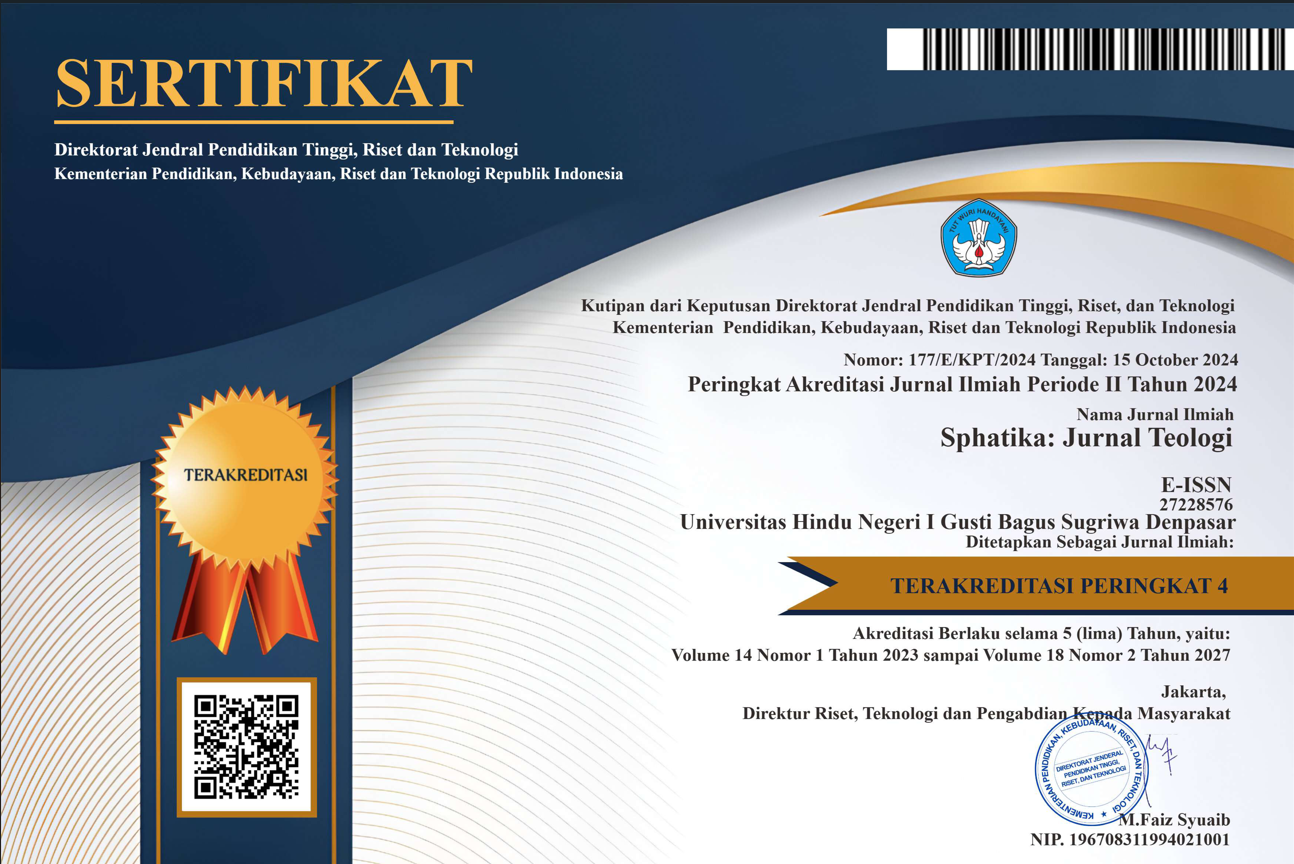Peningkatan Sraddha Bhakti Terhadap Tuhan dalam Kidung Sebun Bangkung
DOI:
https://doi.org/10.25078/sphatika.v13i1.1295Keywords:
increasing sraddha bhakti; kidung sebun bangkungAbstract
Religion in the community is believed to be able to bring a sense of security and peace in human life, and can lead and guide mankind towards happiness in both physical and spiritual life. For society, religion contains the most adequate instructions and life guidelines for humans in living their lives in this world. In Bali, there are many religious literatures in the form of lontars in Sanskrit and Old Javanese translated into Balinese and Indonesian. The deepening of the teachings of God in Hinduism is also called Brahma Widya. The study of Brahma Widya or Theology is very necessary at this time so that the younger generation does not lose track of tracing the activities of their ancestors.
The increase in sraddha and devotion to God contained in the song Sebun Bangkung contains teachings that are in accordance with the teachings of Hinduism. The teachings contained in the Kidung Sebun Bangkung text are tattwa teachings which are shown that Hinduism gives its people the freedom to take any path they want to be able to get closer to God in order to achieve the perfection of outer and inner life. Besides that, there are also Lascarya teachings. The lascarya attitude shown by Candrabherawa king who was willing to practice the teachings of karma sanyaṣa, but did not abandon the teachings of Yoga Sanyasa. King Candrabherawa also kept his promise by offering his son Dyah Ratna Sasangka to be married by King Yudhisthira as a symbol of the union of the teachings of Shiva and Buddha. The lascarya attitude of the Candrabherawa king can unite the two teachings to be able to go hand in hand in harmony and harmony. And the last meaning is the existence of Shiva-Buddhist syncretism which is indicated by the marriage between King Yudhistira and the daughter of King Candrabherawa, Dyah Ratna Sasangka from the Dewantara kingdom. In this story it can be explained that the essence of Shiva and Buddha is the same, side by side and cannot be separated and always go hand in hand and in pairs. Like a man to a woman, a father to a mother, and so on. So the teachings of Karma Sanyaṣa with Yoga Sanyaṣa should be practiced simultaneously.
References
Agastia, I.B.G.1994. Kesusastraan Hindu Indonesia (Sebuah Pengantar). Denpasar : Yayasan Dharma Sastra
Donder, I Ketut. 2006. Brahma Widya Teologi Kasih Semesta. Surabaya: Paramita.
Goris, R.1986. Sekte-Sekte Di Bali. Jakarta : Bhratara Karya Aksara.
Irmayanti, M. Budianto.2004. Ideologi Budaya. Jakarta : Yayasan kota Kita.
Maswinara, I Wayan.1996. Konsep Pañca Sraddhà. Surabaya : Penerbit Paramita.
Mirsha, I Gusti Ngurah Rai, dkk.1994. Wrhaspati Tatwa, Ganapati Tatwa, Tattwa Jnana Kajian Teks dan Terjemahannya. Denpasar : UPD. Kantor Dokumentasi Budaya Bali Propinsi Daerah Tingkat I Bali.
Pudja, G. 1973. Manawa Dharmasastra.
Pudja, G. 1999. Bhagawad Gita. Syrabaya : Paramita.
Pudja, G.1999. Theologi Hindu (Brahma Widya). Jakarta : Mayangsari.
Sanjaya, Putu. 2010. Acara Agama Hindu. Surabaya : Paramita.
Suhardana, K.M. 2009. Panca Sraddha. Surabaya : Paramita.
Swastika, I Ketut Pasek. 2010. Petunjuk Yadnya dan Rerainan Hindu. Denpasar : CV. Kayumas Agung.
Teew, A.1981.”Ilmu Sastra Umum dan Ilmu Sastra Malindo”. Kuliah Fakultas Sastra Universitas
Wiana, Ketut. 2004. Bagaima Hindu Menghayati Tuhan. Denpasar : PT. Pustaka Manik Geni.















